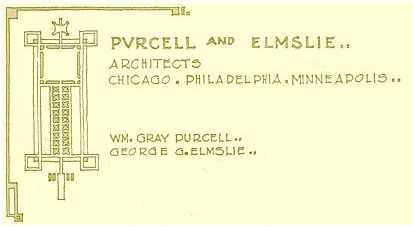 |
firm active: 1907-1921 minneapolis, minnesota :: chicago, illinois |
Biographical Notes: William Gray Purcell (1880-1965)
Biographical essay in Guide to the
William Gray Purcell Papers.
Copyright by Mark Hammons, 1985.
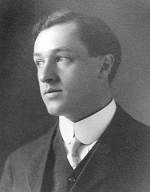 Portrait of William Gray
Purcell, circa 1908
Portrait of William Gray
Purcell, circa 1908
PURCELL AND FEICK, 1907-1909
The period of his first professional
partnership was a time of beginnings for Purcell. During these years he
relocated his home, married, and began the development of his skills in handling
his business. His father settled a large sum of money on him as part of his
inheritance, marking his financial independence. With ample resources, a natural
interest and sensitivity toward others, and a zealous commitment to the precepts
of progressive architecture, Purcell entered into the idealistic pursuit of his
vocation.
Early in 1907, Purcell and George Feick took the northbound train from Chicago
into the sub zero winter of Minnesota. After arriving in Minneapolis they took
rooms in a boardinghouse, rented an office on the tenth floor of the New York
Life Building, and mailed out engraved cards announcing the new architectural
partnership of Purcell & Feick. For the next two and a half years, they
worked to establish their credentials as earnest practitioners of the Sullivan
derived "function and form," or organic, architecture.
The dedication of Purcell & Feick to a new and commercially unaccepted practice
made securing work even more difficult for the fledgling office. The principles
underlying proposed designs often had to be explained to potential clients, a
process that took time and depended on an open mindedness not always present.
The lack of many completed buildings as examples to demonstrate the
effectiveness of their approach was another handicap to gaining commissions that
took time to overcome. During their first year the architects recorded only
twelve entries on their accounting system of which seven were for unrealized
projects, alterations to existing structures, or insignificant consultations.
Throughout these early years Purcell continued to develop his personal and
professional relationship with George Grant Elmslie. When in Chicago, Purcell
would always visit the Sullivan offices in the Auditorium tower to see his
friend and look at the work on the drafting tables. Elmslie gladly consulted on
Purcell's architectural problems and encouraged him to read books by Edward
Carpenter and others. This exposure to the mature and inspired abilities of
Elmslie served to challenge as well as to support his work, and on occasion
Purcell tested his own skills by keeping projects isolated from his mentor.
 Catherine Garns Gray (left), and Edna Summy Purcell (right) seen in a Lumière autochrome taken by William Gray Purcell, 1915 |
Other significant personal relationships also originated during this time. In December 1908 he married Edna Summy, a Wellesley graduate whose father owned a music publishing business in Chicago. The couple honeymooned in the snow covered forest at Island Lake and, when they returned, shared a house with Catherine Gray, who came to Minneapolis to be near her grandson. During 1908 Purcell made the acquaintance of Minnesota architect John Jager, who became a lifelong friend who shared Purcell's interests in architecture and art. This growing sense of family of especially important to Purcell, who often felt frustrated with and even alienated from the many people to failed to respond to the message of organic architectural philosophy.
Many early business relations sprang from contacts with friends of his father or grandfather, such as H. C. Garvin of Winona, Minnesota. Like several small town supporters of Purcell & Feick, Garvin believed in the same philosophy that motivated Purcell and worked to deliver other customers to the firm and provided his own commissions. This growing network of small town businessmen, especially bankers, would eventually broaden opportunities for commissions in Minnesota, Wisconsin, Iowa, and the Dakotas. From contacts in his home town of Sandusky, George Feick, Jr., brought business to the office from Ohio, particularly speculative houses and an office building done for his father, a construction contractor.
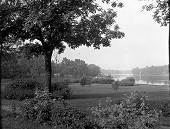 Lake of the Isles, eastern shore, looking southwest, from the vantage of the Catherine Gray residence |
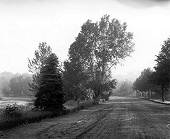 Lake of the Isles Boulevard, looking north, roughly in front of the Catherine Gray residence |
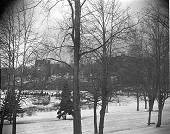 Lake of the Isles, eastern shore, looking north, from the vantage of the Catherine Gray residence |
The residential work of the firm began with a house built in 1907 by Purcell for his own use and later named in honor of his grandmother, the Catherine Gray residence. After a frustrating and time consuming first attempt that failed to yield any useful results, Purcell tried anew by consulting with George Elmslie on a plan that integrated, among other aspects of the composition, a lot with a lake view and the desire for a detached pavilion porch. Purcell used an initial sketch by Elmslie to compose the elevations and to articulate conscientiously a structural technique that addressed his philosophical concerns about the functional use of materials.
Several significant features refined in many later designs made their first
appearance in the Catherine Gray house. The use of a tented ceiling and
outwardly opening casement windows were elements that would be used
consistently. A new system of interior wood trim was developed to emphasize the
enclosing sense of the walls, rather than the traditionally accentuated openings
of windows and doors. The fireplace for the house was built with a raised
hearth, another important element that would be carried forward to other work.
One of the disadvantages found in this design and representing a problem that
would often to be encountered in the future was the economic need to incorporate
pre existing furniture in the new building. The design of such older pieces
almost always seen to affected negatively the values of the architecture.
The firm furthered their ideas about residential design through submissions to
various competitions and the practical experience gained by doing alterations.
In March 1908 the F. W. Bird Company, a manufacturer of paper building
materials, sponsored a competition to demonstrate the variety of uses to which
their products could be applied. Purcell & Feick entered a design that employed
the Bird Company building papers to enclose an open floor plan in a structurally
innovative fashion. Although the judges selected a traditional design in
preference to the Purcell & Feick entry, the effort of the firm to work with an
open plan was the beginning of a series of similar residences built by the
Purcell partnerships over the next decade.
A month after the Bird Company competition the firm met their first would be
home owner, Minneapolitan Arthur Jones who wanted to remodel a small barn into a
residence. An open floor plan similar to the Bird design was devised that also
featured an unconventional window treatment. Pleased with the results and
hopeful of getting some favorable publicity, Purcell & Feick made a study for a
similar house that they wanted to appear in the Ladies Home Journal. The plan
accomplished the feat of including five well proportioned bedrooms in a two
story plus attic house measuring only twenty two by thirty feet, but whether the
design was actually submitted for publication is unknown. Such experiments came
to yield practical results. Although the plan for the Journal was never actually
constructed, a cottage based in part on the design was built for J. D. R. Steven
in Eau Claire, Wisconsin, during the spring of 1909. The harmonious arrangement
of the Steven cottage so pleased the owner that when a second, larger and more
formal house was required, Purcell & Feick got the commission.
Another early problem considered by the architects was the integration of modern
mechanical conveniences into both residential and commercial design. Devices
such as refrigerators were necessary to modern kitchens, and housing plans often
had to accommodate the growing presence of the automobile in American life. For
example, the 1907 plans for an unbuilt group of duplexes residence in Winona,
Minnesota, included a large garage for each living unit. Purcell believed the
new mechanical accoutrements for living both deserved and required equally as
poetic expression in design as did the more basic requirements of human shelter,
a conviction bolstered by his enthusiastic response in 1908 to The Voice of the
Machines by Gerald Stanley Lee.
The first Purcell & Feick dwelling whose plan included a garage was built for
Purcell's father in River Forest, Illinois, in 1909. Purcell had trouble finding
a solution for the house within the imposed economic limits and came to regard
his unaided completion of the design for the Charles A. Purcell residence as a
point of honor. Relying solely on his own ideas, Purcell completed the residence
and a slightly self conscious garage for a total of $15,500, including the lot.
Earlier in 1908 the firm had built what Purcell regarded as the first garage in
Minneapolis designed specifically for the service of automobiles. Featuring
several innovative elements, the Motor Inn was done for Henry Goosman, who had
for many years maintained a thriving livery business. The wide, round entrance
door opened through a special electrohydraulic lift mechanism, and a novel
sidewalk-like ledge that served as an interior curb within the building was also
useful as a handy area for tools and temporary storage. Inside the office, a
graduated horizontal wood trim effected a streamlined wall treatment, the whole
design reflecting the sense of movement and change that was the experience of
the automobile.
The two churches built during the partnership of Purcell & Feick represented
diametrically opposed attitudes on the part of the different clients who
commissioned them. As architects who were convinced practitioners of the
Sullivan philosophy, the demands of the rector and vestry of Christ Church in
Eau Claire, Wisconsin, posed something of a dilemma. The prosperous lumbermen
who comprised the building committee made clear their preference for a
traditional approach. Unable to lead their clients toward new and unfamiliar
forms, Purcell and Feick decided to give the congregation a simple but clearly
historically inspired structure that at least had the honesty of using genuine
masonry walls and wooden roof trusses uncluttered by obscuring ornament.
A completely different situation occurred with the Stewart Memorial Church of
1909. The church elders were persuaded that a nontraditional design, a cube
shaped church with a flat roof and missing the customary steeple, was the most
economical to build as well as being a better statement of modern Protestant
practice. Since the assembly could not afford to complete both the sanctuary and
a Sunday school wing at the same time, wall sized sliding doors that would later
open into flanking auditorium space to be located in the unbuilt section were
temporarily covered as exterior walls. In his first publication written to argue
for an honest American building art, Purcell expounded upon the functionalist
qualities of the design in an article entitled "Expressions in Church
Architecture," which appeared in the successor magazine to his grandfather's
weekly, The Interior.
Sometimes commissions were lost despite the best educational efforts of the
firm, and even when the client was willing to listen, Purcell was not always
successful in his attempts to overcome the common taste for revivalist forms.
Some clients were simply unwilling to change their minds about what constituted
the appropriate appearance of a building. Purcell recommended to one group of
potential bank builders that they visit the Farmers' National Bank just then
being completed in Owatonna, Minnesota, but the richness and radical composition
of the Sullivan bank disturbed more than enlightened them. To convey an
understanding of the integrated concepts on which Purcell & Feick based their
proposal for the First National Bank in Winona, Minnesota, the firm resorted to
a plaster model for which, Purcell discovered, the clients had even less of an
affinity.
On other projects, Purcell discovered that the clients either did not know what
they needed or actually wanted something totally different from what they had
said. For example, in designing a house for the wealthy E. C. Warner that would
have overlooked Lake Calhoun in Minneapolis, Purcell took seriously the
financial limit of forty thousand dollars. He approached the project intent on
creating a comfortable and practical living space without making arbitrary
decisions for the client and, as a guide to possible square footage, he wrote to
Louis Sullivan requesting plans for the Bradley and Babson residences, which had
cost similar amounts. Purcell prepared a series of large presentation drawings
that allowed for a participation in the design process that Mr. Warner was
disinclined to enjoy. The commission went to a competitor who presented an
inflexible design with all details already fixed, and the ultimate expense of
the residence was much more than the client had originally expressed the desire
to spend.
As he would later express in many of his writing and correspondence, the
disappointments and the successes of his architectural practice were considered
by Purcell as landmarks in the valiant battle to an indigenous American
architecture. In the first two years of their work, the firm of Purcell & Feick
had made a successful beginning in carrying on that struggle. During that time
he had also established a social life with people who shared his values.
Surrounded by supportive family, friends, and associates, Purcell was eager for
the challenges that lay ahead and filled with hope that the best was yet to
come.
PURCELL, FEICK AND ELMSLIE, 1910-1912